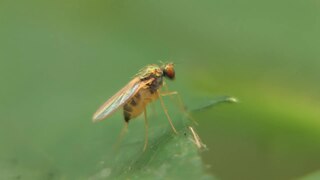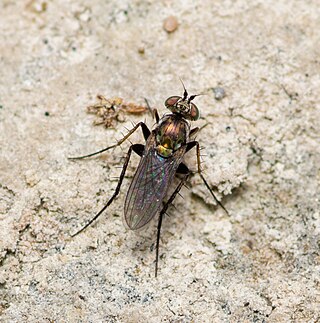
Muscoidea is a superfamily of flies in the subsection Calyptratae. Muscoidea, with approximately 7000 described species, is nearly 5% of the known species level diversity of the Diptera, the true flies. Most muscoid flies are saprophagous, coprophagous or necrophagous as larvae, but some species are parasitic, predatory, or phytophagous. In September 2008, a study was done on the superfamily using both nucleic and mitochondrial DNA and the conclusion suggested that Muscoidea may actually be paraphyletic.

Limoniidae is the largest of four crane fly families, with more than 10,700 species in more than 150 genera. Some studies have suggested it to be a paraphyletic group, with some limoniids being more closely related to Tipulidae and Cylindrotomidae than to other limoniids. Limoniid crane flies can usually be distinguished by the way the wings are held at rest. Limoniids usually hold/fold the wings along the back of the body, whereas other crane flies usually hold them out at right angles. Snow flies such as Chionea scita have no wings at all. Limoniids are also usually smaller than other crane flies, with some exceptions.

Empididae is a family of flies with over 3,000 described species occurring worldwide in all the biogeographic realms but the majority are found in the Holarctic. They are mainly predatory flies like most of their relatives in the Empidoidea, and exhibit a wide range of forms but are generally small to medium-sized, non-metallic and rather bristly.

The Celyphidae, commonly known as beetle flies or beetle-backed flies, are a family of flies. About 115 species in about 9 genera are known chiefly from the Oriental and Afrotropic biogeographic regions with one lineage in the New World.

Tachydromia is a genus of hybotid flies. It is widespread around the world, with species found essentially everywhere except the polar regions and some remote islands. They are not very diverse in East and Southeast Asia, or in Africa

Chrysotimus is a genus of longlegged flies in the family Dolichopodidae. It is cosmopolitan in distribution, but it is probably paraphyletic with respect to several genera of limited distribution.

Neurigona is a genus of flies in the family Dolichopodidae. It is a large genus, with over 150 known species.

Paraclius is a genus of flies in the family Dolichopodidae. It is currently considered a polyphyletic assemblage of species.

Xanthochlorus is a genus of flies in the family Dolichopodidae. It is the only member of the subfamily Xanthochlorinae. In some classifications, the genus is included in the subfamily Sympycninae.

Ocydromia is a genus of flies in the family Hybotidae.

Hybos is a genus of hybotid flies.

Empidinae, also called dance flies, are a subfamily of empidoid flies. They are mainly predatory flies like most of their relatives, and generally small to medium-sized. Most species are flower visitors and they can be effective pollinators.
Calohilara elegans is a species of fly in the family Empididae endemic to Myanmar.
Chelifera is a genus of flies in the family Empididae.

Ateuchosaurus chinensis, the Chinese short-limbed skink or Chinese ateuchosaurus, is a species of skink. It is found in China and Vietnam.

Oedalea is a genus of flies in the family Hybotidae.
Parahybos is a genus of flies in the family Hybotidae.

Crossopalpus is a genus of flies in the family Hybotidae.













